Posture Exercises that Will Make You Feel Better
Do you spend a lot of time sitting in front of screens and find yourself slouching more often than not? Well, you’re not alone! The truth is good posture exercises are often neglected in our sedentary lifestyles. But don’t worry because we’ve got you covered. In this article, we’ll show you some amazing exercises that will help you stand good and confident, both inside and out. And the best part? They’re super easy and effective! So, get ready to transform your posture and feel better than ever before. Let’s begin the journey to a happier and healthier you!
- Part 1. Posture Exercises To Make You Feel Better
- Part 1.1 Tree Pose
- Part 1.2 Neck Retraction Exercises
- Part 1.3 Shoulder Blade Squeeze
- Part 1.4 Chin Tucks
- Part 1.5 Wall Angels
- Part 1.6 Cat-Cow Stretch
- Part 1.7 Neck Stretch
- Part 1.8 Child’s Pose
- Part 2. Few Tips and Techniques
- Part 2.1 Core Strengthening
- Part 2.2 Desk Posture Corrector
- Part 2.3 Chest Openers
- Part 2.4 Seated Posture Boosters
- Part 2.5 Pilates and Tai Chi
- Part 2.6 The Alexander Technique
Part 1. Posture Exercises To Make You Feel Better
Yoga offers a treasure trove of posture-enhancing exercises. It is good for posture and purifies your body and soul. Explore some of the exercises to help posture correction and make you healthier are listed here:
1. Tree Pose
Our first body posture exercise is the Tree Pose, or Vrikshasana, which helps promote balance and alignment.
- Stand on one leg, bringing the sole of the other foot to the inner thigh or calf.
- Engage your core, lengthen your spine, and feel the improvement in your balance and overall posture.

2. Neck Retraction Exercises
Constantly peering at screens contributes to the notorious “tech neck.” Counteract this by incorporating neck retraction exercises.
- Gently bring your head back, aligning it with your spine, and hold for a few seconds.
This simple move helps alleviate neck strain and cultivates a neutral neck position.
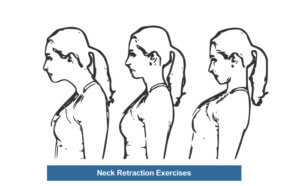
3. Shoulder Blade Squeeze
3. Shoulder Blade Squeeze
The Shoulder Blade Squeeze is a simple exercise to strengthen the muscles between your shoulder blades.
- Make sure to sit or stand up straight while keeping your shoulders relaxed.
- Inhale and gently squeeze your shoulder blades together.
- Now, hold the squeeze for 5 to 10 seconds. Exhale and release the squeeze. Repeat 10-15 times and gradually increase.

4. Chin Tucks
4. Chin Tucks
Chin tucks is a neck exercise that can help rectify posture and alleviate neck pain.
- Sit or stand with a straight spine.
- Gently tuck your chin towards your chest.
- Hold for a few seconds, then release.
- Repeat the chin tucks for about 10-15 repetitions.

5. Wall Angels
Wall Angels are a stretching and mobility exercise that can help improve posture and shoulder mobility.
- Stand with your back against a wall.
- Lift your arms to shoulder level while bending your elbows at a 90-degree angle.
- Press your arms and the back of your hands against the wall, forming a “W” shape with your arms.
- Slide your arms up and down while keeping in contact with the wall.
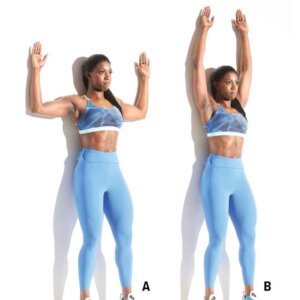
6. Cat-Cow Stretch
The Cat-Cow Stretch is a commonly used yoga exercise to enhance spinal flexibility and relieve tension in the back.
- Assume a tabletop position with wrists under shoulders and knees under hips.
Cat Pose:
- As you arch your back, inhale deeply and gently drop your belly towards the floor.
- Slowly lift your head and tailbone towards the ceiling, creating a concave shape in your spine.
Cow Pose:
- As you round your back, exhale and tuck your chin to your chest.
- Flow between the Cat and Cow positions for a gentle and rhythmic stretch. Inhale for Cow, exhale for Cat.
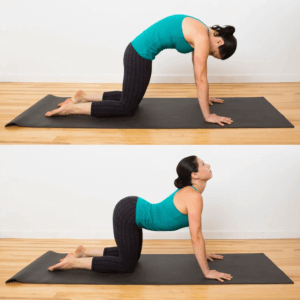
7. Neck Stretch
Stretching your neck can help alleviate tension and enhance flexibility.
- Begin by gently tilting your head to one side, bringing your ear toward your shoulder in a slow and controlled motion.
- Maintain this position for 15-30 seconds, allowing the stretch to gradually release tension in your neck.
- Also, remember to breathe deeply and relax your shoulders during the stretch.
- After completing one side, switch to the other side to ensure a balanced stretch for both sides of your neck.
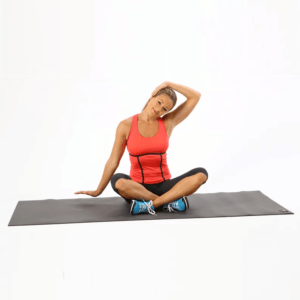
8. Child’s Pose
8. Child’s Pose
Child’s Pose is a relaxing and restorative exercise that stretches and releases tension in the back, shoulders, and neck.
- Kneel on the floor, sit back on your heels, and reach your arms forward.
- Hold the stretch for 20-30 seconds.
- Allow your spine to lengthen and your back to relax and focus on deep, slow breaths.
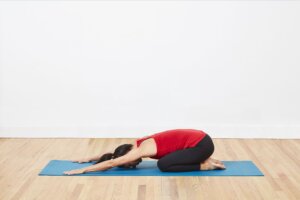
Incorporating these exercises into your routine to improve posture, alleviate stiffness, and enhance overall well-being. It is important to consult a healthcare professional before beginning a new exercise routine, especially if you have pre-existing medical conditions.
Part 2. Few Tips and Techniques
Here are a few tips and techniques that could help you feel better and perform workouts for posture in a better way:
Core Strengthening
A robust core forms the backbone of good posture. Engage in exercises like planks, leg raises, and bicycle crunches to fortify your core muscles. A strong core provides stability, preventing slouching and supporting the spine’s natural curvature.
Desk Posture Corrector
Poor desk posture can cause back pain, neck pain, and headaches. It is essential to improve it for a good, confident, and healthy posture.
- Position your computer monitor at eye level so that you don’t have to tilt your head up or down.
- Ensure to stand up, stretch, and walk around at least once every hour.
- Place your keyboard and mouse close enough to avoid overreaching and wrists bending.
- Sit back in your chair with your back straight and shoulders relaxed.
Chest Openers
Sitting for prolonged periods can tighten chest muscles, contributing to rounded shoulders. Counteract this by incorporating chest-opening exercises. A simple doorway stretch or yoga pose like the Cobra or Fish pose can enhance flexibility and counteract the effects of slouching.
Seated Posture Boosters
For those tethered to desks, seated exercises offer a discreet way to enhance posture. Shoulder blade squeezes and seated cat-cow stretches, which we explored above in the exercises section, can be seamlessly integrated into your posture exercises gym routine. This can help you in promoting spinal flexibility and relieve tension.
Pilates and Tai Chi
Pilates and Tai Chi are two practices that combine physical and mental elements, promoting a sense of mind-body harmony. Pilates focuses on producing core strength and flexibility, while Tai Chi’s flowing movements help to boost balance and posture. By performing these practices in your daily routine, you can have a multitude of holistic benefits. Also, it makes you feel more centered and physically and mentally aligned.
The Alexander Technique
The Alexander Technique emphasizes mindfulness in movement. Regularly check in with your posture, paying attention to how you sit, stand, and move. Mindful awareness lays the foundation for lasting posture improvements, fostering a more conscious and aligned way of being.
Conclusion
Did you know that incorporating posture exercises into your daily routine can greatly improve your well-being? It’s not just about standing up straight. It’s a holistic approach to feeling your best. These exercises go beyond physical appearance, impacting your overall health and mood positively.
By engaging core muscles and promoting spinal alignment, these exercises alleviate tension, reduce the risk of musculoskeletal issues, and enhance your body’s efficiency. And let’s not forget about the mental benefits – good workouts for posture foster confidence and a positive self-image. Who doesn’t want that, right? Remember, feeling better starts from within, and maintaining good posture is a small yet transformative step towards a healthier, happier you!
